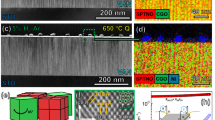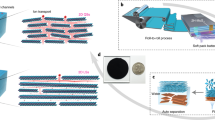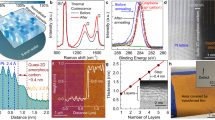Abstract
The scalable and sustainable manufacture of thick electrode films with high energy and power densities is critical for the large-scale storage of electrochemical energy for application in transportation and stationary electric grids. Two-dimensional nanomaterials have become the predominant choice of electrode material in the pursuit of high energy and power densities owing to their large surface-area-to-volume ratios and lack of solid-state diffusion1,2. However, traditional electrode fabrication methods often lead to restacking of two-dimensional nanomaterials, which limits ion transport in thick films and results in systems in which the electrochemical performance is highly dependent on the thickness of the film1,2,3,4. Strategies for facilitating ion transport—such as increasing the interlayer spacing by intercalation5,6,7,8 or introducing film porosity by designing nanoarchitectures9,10—result in materials with low volumetric energy storage as well as complex and lengthy ion transport paths that impede performance at high charge–discharge rates. Vertical alignment of two-dimensional flakes enables directional ion transport that can lead to thickness-independent electrochemical performances in thick films11,12,13. However, so far only limited success11,12 has been reported, and the mitigation of performance losses remains a major challenge when working with films of two-dimensional nanomaterials with thicknesses that are near to or exceed the industrial standard of 100 micrometres. Here we demonstrate electrochemical energy storage that is independent of film thickness for vertically aligned two-dimensional titanium carbide (Ti3C2Tx), a material from the MXene family (two-dimensional carbides and nitrides of transition metals (M), where X stands for carbon or nitrogen). The vertical alignment was achieved by mechanical shearing of a discotic lamellar liquid-crystal phase of Ti3C2Tx. The resulting electrode films show excellent performance that is nearly independent of film thickness up to 200 micrometres, which makes them highly attractive for energy storage applications. Furthermore, the self-assembly approach presented here is scalable and can be extended to other systems that involve directional transport, such as catalysis and filtration.
This is a preview of subscription content, access via your institution
Access options
Access Nature and 54 other Nature Portfolio journals
Get Nature+, our best-value online-access subscription
$29.99 / 30 days
cancel any time
Subscribe to this journal
Receive 51 print issues and online access
$199.00 per year
only $3.90 per issue
Buy this article
- Purchase on SpringerLink
- Instant access to full article PDF
Prices may be subject to local taxes which are calculated during checkout




Similar content being viewed by others
References
Anasori, B., Lukatskaya, M. R. & Gogotsi, Y. 2D metal carbides and nitrides (MXenes) for energy storage. Nat. Rev. Mater. 2, 16098 (2017).
Raccichini, R., Varzi, A., Passerini, S. & Scrosati, B. The role of graphene for electrochemical energy storage. Nat. Mater. 14, 271–279 (2015).
Gogotsi, Y. & Simon, P. Materials science. True performance metrics in electrochemical energy storage. Science 334, 917–918 (2011).
Lukatskaya, M. R., Dunn, B. & Gogotsi, Y. Multidimensional materials and device architectures for future hybrid energy storage. Nat. Commun. 7, 12647 (2016).
Zhao, M.-Q. et al. Flexible MXene/carbon nanotube composite paper with high volumetric capacitance. Adv. Mater. 27, 339–345 (2015).
Ling, Z. et al. Flexible and conductive MXene films and nanocomposites with high capacitance. Proc. Natl Acad. Sci. USA 111, 16676–16681 (2014).
Lukatskaya, M. R. et al. Cation intercalation and high volumetric capacitance of two-dimensional titanium carbide. Science 341, 1502–1505 (2013).
Luo, J. et al. Pillared structure design of MXene with ultralarge interlayer spacing for high-performance lithium-ion capacitors. ACS Nano 11, 2459–2469 (2017).
Sun, H. et al. Three-dimensional holey-graphene/niobia composite architectures for ultrahigh-rate energy storage. Science 356, 599–604 (2017).
Zhu, C. et al. Supercapacitors based on three-dimensional hierarchical graphene aerogels with periodic macropores. Nano Lett. 16, 3448–3456 (2016).
Miller, J. R., Outlaw, R. A. & Holloway, B. C. Graphene double-layer capacitor with ac line-filtering performance. Science 329, 1637–1639 (2010).
Yoon, Y. et al. Vertical alignments of graphene sheets spatially and densely piled for fast ion diffusion in compact supercapacitors. ACS Nano 8, 4580–4590 (2014).
Chen, J., Zheng, B. & Lu, G. Vertically-Oriented Graphene: PECVD Synthesis and Applications Ch. 7 (Springer, Cham, 2015).
Jalili, R. et al. Processable 2D materials beyond graphene: MoS2 liquid crystals and fibres. Nanoscale 8, 16862–16867 (2016).
Narayan, R., Kim, J. E., Kim, J. Y., Lee, K. E. & Kim, S. O. Graphene oxide liquid crystals: Discovery, evolution and applications. Adv. Mater. 28, 3045–3068 (2016).
Van der Kooij, F. M., Kassapidou, K. & Lekkerkerker, H. N. W. Liquid crystal phase transitions in suspensions of polydisperse plate-like particles. Nature 406, 868–871 (2000).
Safinya, C. R. et al. Structure of membrane surfactant and liquid crystalline smectic lamellar phases under flow. Science 261, 588–591 (1993).
Mang, J. T., Kumar, S. & Hammouda, B. Discotic micellar nematic and lamellar phases under shear flow. Europhys. Lett. 28, 489 (1994).
Bruinsma, R. F. & Safinya, C. R. Landau theory of the nematic-smectic-A phase transition under shear flow. Phys. Rev. A 43, 5377–5404 (1991).
Bruinsma, R. & Rabin, Y. Shear-flow enhancement and suppression of fluctuations in smectic liquid crystals. Phys. Rev. A 45, 994–1008 (1992).
McDermott, D. C., Lu, J. R., Lee, E. M., Thomas, R. K. & Rennie, A. R. Study of the adsorption from aqueous solution of hexaethylene glycol monododecyl ether on silica substrates using the technique of neutron reflection. Langmuir 8, 1204–1210 (1992).
Hu, T. et al. Interlayer coupling in two-dimensional titanium carbide MXenes. Phys. Chem. Chem. Phys. 18, 20256–20260 (2016).
Ghidiu, M., Lukatskaya, M. R., Zhao, M.-Q., Gogotsi, Y. & Barsoum, M. W. Conductive two-dimensional titanium carbide ‘clay’ with high volumetric capacitance. Nature 516, 78–81 (2014).
Onuki, A. & Kawasaki, K. Nonequilibrium steady state of critical fluids under shear flow: a renormalization group approach. Ann. Phys. 121, 456–528 (1979).
De Gennes, P. G. Effect of shear flows on critical fluctuations in fluids. Mol. Cryst. Liq. Cryst. 34, 91–95 (1976).
Lukatskaya, M. R. et al. Probing the mechanism of high capacitance in 2D titanium carbide using in situ X-ray absorption spectroscopy. Adv. Energy Mater. 5, 1500589 (2015).
Lukatskaya, M. R. et al. Ultra-high-rate pseudocapacitive energy storage in two-dimensional transition metal carbides. Nat. Energy 2, 17105 (2017).
Bo, Z. et al. Vertically oriented graphene bridging active-layer/current-collector interface for ultrahigh rate supercapacitors. Adv. Mater. 25, 5799–5806 (2013).
Acerce, M., Voiry, D. & Chhowalla, M. Metallic 1T phase MoS2 nanosheets as supercapacitor electrode materials. Nat. Nanotechnol. 10, 313–318 (2015).
Stoykovich, M. P. & Nealey, P. F. Block copolymers and conventional lithography. Mater. Today 9, 20–29 (2006).
Shahzad, F. et al. Electromagnetic interference shielding with 2D transition metal carbides (MXenes). Science 353, 1137–1140 (2016).
Xie, X. et al. Porous heterostructured MXene/carbon nanotube composite paper with high volumetric capacity for sodium-based energy storage devices. Nano Energy 26, 513–523 (2016).
Hogan, B. T., Kovalska, E., Craciun, M. F. & Baldycheva, A. 2D material liquid crystals for optoelectronics and photonics. J. Mater. Chem. C 5, 11185–11195 (2017).
Lin, F., Tong, X., Wang, Y., Bao, J. & Wang, Z. M. Graphene oxide liquid crystals: synthesis, phase transition, rheological property, and applications in optoelectronics and display. Nanoscale Res. Lett. 10, 435 (2015).
Aboutalebi, S. H., Gudarzi, M. M., Zheng, Q. B. & Kim, J.-K. Spontaneous formation of liquid crystals in ultralarge graphene oxide dispersions. Adv. Funct. Mater. 21, 2978–2988 (2011).
Akbari, A. et al. Large-area graphene-based nanofiltration membranes by shear alignment of discotic nematic liquid crystals of graphene oxide. Nat. Commun. 7, 10891 (2016).
Behabtu, N. et al. Spontaneous high-concentration dispersions and liquid crystals of graphene. Nat. Nanotechnol. 5, 406–411 (2010).
Dan, B. et al. Liquid crystals of aqueous, giant graphene oxide flakes. Soft Matter 7, 11154–11159 (2011).
He, L. et al. Graphene oxide liquid crystals for reflective displays without polarizing optics. Nanoscale 7, 1616–1622 (2015).
Kim, J. E. et al. Graphene oxide liquid crystals. Angew. Chem. Int. Ed. 50, 3043–3047 (2011).
Liu, H. et al. A lyotropic liquid-crystal-based assembly avenue toward highly oriented vanadium pentoxide/graphene films for flexible energy storage. Adv. Funct. Mater. 27, 1606269 (2017).
Liu, Y., Xu, Z., Gao, W., Cheng, Z. & Gao, C. Graphene and other 2D colloids: Liquid crystals and macroscopic fibers. Adv. Mater. 29, 1606794 (2017).
Shen, T.-Z., Hong, S.-H. & Song, J.-K. Electro-optical switching of graphene oxide liquid crystals with an extremely large Kerr coefficient. Nat. Mater. 13, 394–399 (2014).
Xu, Z. & Gao, C. Graphene chiral liquid crystals and macroscopic assembled fibres. Nat. Commun. 2, 571 (2011).
Zakri, C. et al. Liquid crystals of carbon nanotubes and graphene. Philos. Trans. R. Soc. A 371, 20120499 (2013).
Hogan, B. T. et al. Dynamic in-situ sensing of fluid-dispersed 2D materials integrated on microfluidic Si chip. Sci. Rep. 7, 42120 (2017).
Kravets, V. G. et al. Engineering optical properties of a graphene oxide metamaterial assembled in microfluidic channels. Opt. Express 23, 1265–1275 (2015).
Mashtalir, O., Lukatskaya, M. R., Zhao, M.-Q., Barsoum, M. W. & Gogotsi, Y. Amine-assisted delamination of Nb2C MXene for Li-ion energy storage devices. Adv. Mater. 27, 3501–3506 (2015).
Zhang, Y., Lo, C.-W., Taylor, J. A. & Yang, S. Replica molding of high-aspect-ratio polymeric nanopillar arrays with high fidelity. Langmuir 22, 8595–8601 (2006).
Acknowledgements
We thank W.-S. Wei and Z. Davison for providing insights into the assembly of discotic liquid crystals in our experiments. We acknowledge support from the National Science Foundation Materials Science and Engineering Center Grant to the University of Pennsylvania, DMR-1120901 and DMR-1720530 (to S.Y.). Work on MXene synthesis and electrochemical characterization at Drexel University was supported by the Fluid Interface Reactions, Structures & Transport Center, an Energy Frontier Research Center funded by the US Department of Energy, Office of Science, Office of Basic Energy Sciences (to Y.G.).
Author information
Authors and Affiliations
Contributions
Y.X., T.S.M., M.-Q.Z., Y.G. and S.Y. conceived the idea and designed the experiments. Y.X., T.S.M. and M.-Q.Z. performed the experiments. Z.Z., A.D., H.C. and B.A. helped with the experiments. Y.G. and S.Y. supervised the work. Y.X. and T.S.M. drafted the manuscript, and all the authors contributed to the editing of the manuscript.
Corresponding authors
Ethics declarations
Competing interests
The authors declare no competing interests.
Additional information
Publisher’s note: Springer Nature remains neutral with regard to jurisdictional claims in published maps and institutional affiliations.
Extended data figures and tables
Extended Data Fig. 1 Size statistics of MXene nanosheets.
a, SEM image of the nanosheets. The flake dimensions used to report the length and width of the sheets are marked. b, Size distribution of MXene nanosheets, measured from SEM over 250 sheets. c, Average sizes of the nanosheets.
Extended Data Fig. 2 POM images of MXene aqueous solutions.
a, At a concentration of 50 mg ml−1, the MXene solution shows a nearly isotropic phase with low birefringence under crossed polarizers. b, At a concentration of 250 mg ml−1, higher birefringence starts to appear. A nematic phase is formed, as clearly indicated from the Schlieren texture shown in the inset. c, d, POM images of the slow-appearing MXene liquid-crystal phase on top of one-dimensional microchannels at two polarizer angles: 45° (c) and 0° (d). Higher birefringence starts to appear when water evaporates, and the resulting nematic liquid-crystal phase of MXene can be well aligned with microchannels. The microchannels used here have the following dimensions: diameter 2 µm, spacing 2 µm and depth 1.5 µm. The Onsager theory of liquid crystals predicts the formation of the liquid-crystal phase as a function of the volume fraction of molecules in a media: low volume fraction gives an isotropic phase, and high volume fraction gives a liquid-crystal phase. The empirical value of the critical volume fraction of liquid-crystal phase formation can be estimated by \(\varphi \approx \frac{4T}{W}\), where Φ is the critical volume fraction, W and T are the width and thickness of the nanosheet, respectively. In our MXene system, Φ is estimated to be around 2 vol%, which is equivalent to about 80 mg ml−1 of MXene nanosheets in aqueous solution. However, because the MXene nanosheets are highly polydisperse in terms of size, and the surface charges differ from system to system, the critical value of Φ could vary in experiments. In this work, we demonstrated the isotropic phase of MXene liquid crystal at around 50 mg ml−1, in good agreement with theory, and we showed the nematic phase of MXene at around 250 mg ml−1. This concentration was chosen to be sufficiently high above the critical value of Φ such that a liquid-crystal phase could be ensured.
Extended Data Fig. 3 SEM image of nematic MXene liquid crystal after mechanical shear.
Horizontally aligned MXene nanosheets are obtained.
Extended Data Fig. 4 Schematic of the preparation of MXLLC films.
a, Preparation of the MXLLC slurry. b, Fabrication of the liquid-crystal cell. c, Separation of the MXLLC layer from the liquid-crystal cell. d, The free-standing MXLLC film obtained after supercritical drying.
Extended Data Fig. 5 POM and SEM images of MXLLC films.
a, b, POM images of MXLLC before (a) and after (b) shear. The inset of b shows the POM image of the MXLLC with the shear direction parallel to the polarizer. c–h, Views of the MXLLC film from SEM: random alignment before shear (c), vertical alignment after shear (d), lateral views (e, f), front views (g, h). Dashed red lines indicate the bending directions of the MXene layers.
Extended Data Fig. 6 AFM images of the spin-coated flat MXene film.
a, Height map. b, Film thickness measured across the boundary of the film and the glass. The thickness of the flat MXene film is estimated to be about 30 nm.
Extended Data Fig. 7 SEM images of a vacuum-filtered MXene–SWCNT paper with a thickness of around 35 µm.
a, The full cross-section of the freestanding film. b, A higher-magnification image of the top portion of a. Both images show horizontally stacked layers of MXene nanosheets interpenetrated with SWCNTs, a configuration that has been reported to facilitate ion diffusion1.
Extended Data Fig. 8 Plots of the anodic peak current against scan rate and peak separation against scan rate.
a, Plot of the peak current of the second pair of redox peaks seen at −0.4 V and – 0.6 V versus Hg/HgSO4 in the voltammograms for the MXLCC electrodes in Fig. 3a. b, Plot of the peak separation (ΔEp) for the second pair of redox peaks; the dashed line corresponds to the expected trend for a quasi-electrochemical process2. From a it can be seen that the trend of the current against scan rate of the anodic peak of the second pair of redox peaks is similar (Fig. 3c) to that of the main peaks at – 0.8 V versus Hg/HgSO4 (Fig. 3a), which are characteristic of Ti3C2Tx. The main difference in behaviour for this second pair of peaks compared with previous reports on Ti3C2Tx can be seen in b. Previous characterization of the peak separation against the scan rate for the redox peaks in thin (around 90 nm) Ti3C2Tx electrodes showed a region at low scan rates that corresponds to quasi-equilibrium behaviour3; it is clear from b that this is not the case for the second pair of redox peaks of the MXLLC electrodes. The primary reason for this is probably the large difference in thickness of the MXLLC electrodes (200 μm) compared with previous reports of thin Ti3C2Tx electrodes (90 nm).
Extended Data Fig. 9 Cyclic voltammograms of pure Ti3C2Tx vacuum-filtered paper and MXLLC film.
a, For the second pair of redox peaks at 0.6 V versus the reference, the current grows slightly during cycling and then stabilizes during continuous cycling. b, The current will fade if the cell is allowed to rest. This pair of peaks is thought to originate from changes occurring in the transition-metal surface of the MXene during cycling and will be the subject of further studies. It is thought that these peaks are more pronounced in the cyclic voltammograms of the MXLLC samples owing to the large amount of active material surface that is exposed to the electrolyte in the MXLLC samples relative to the vacuum-filtered papers. c, d, Cyclic voltammograms of a 35-µm-thick vacuum-filtered MXene paper (c) and a 40-µm-thick MXLLC film (d). For similar film thicknesses, MXLLC films have much better rate-handling ability compared to the vacuum-filtered papers, as only a small decay of the cyclic voltammogram is observed until high scan rates are used.
Extended Data Fig. 10 Capacitance retention as a function of scan rate for both vacuum-filtered films and MXLLC films.
All data points are normalized to the capacitance value at 10 mV s−1 for each sample curve, respectively. At 2,000 mV s−1, vacuum-filtered MXene papers retain around 14% (35 µm thick) and 30% (6 µm thick) capacitance, whereas MXLLC films maintain more than 75% capacitance over a wide range of film thickness from 40 µm to 200 µm. However, in thicker (320 µm) MXLLC films, the retention curve starts to behave similarly to that of thin vacuum-filtered paper (6 µm). These data again suggest that the optimal thickness of the working-electrode film of MXLLC is 200 µm.
Supplementary information
Video 1: Polarized optical microscope (POM) images demonstrating MXene nanosheets aligned by microchannels during water evaporation.
MXene aqueous solution is sandwiched between a patterned epoxy substrate and a flat glass. As water gradually evaporated from the right side of the sample, the MXene LC phase began to form and aligned. Video is accelerated by 4x.
Rights and permissions
About this article
Cite this article
Xia, Y., Mathis, T.S., Zhao, MQ. et al. Thickness-independent capacitance of vertically aligned liquid-crystalline MXenes. Nature 557, 409–412 (2018). https://doi.org/10.1038/s41586-018-0109-z
Received:
Accepted:
Published:
Issue Date:
DOI: https://doi.org/10.1038/s41586-018-0109-z
This article is cited by
-
Unlocking Novel Functionality: Pseudocapacitive Sensing in MXene-Based Flexible Supercapacitors
Nano-Micro Letters (2025)
-
One-step gas-phase syntheses of few-layered single-phase Ti2NCl2 and Ti2CCl2 MXenes with high stabilities
Nature Communications (2024)
-
Supramolecular polymers form tactoids through liquid–liquid phase separation
Nature (2024)
-
Scalable ultrastrong MXene films with superior osteogenesis
Nature (2024)
-
Comparing specific capacitance in rice husk-derived activated carbon through phosphoric acid and potassium hydroxide activation order variations
Scientific Reports (2024)



